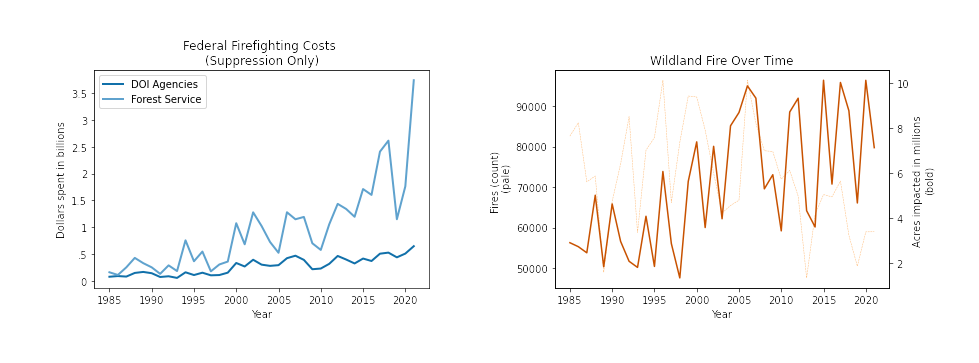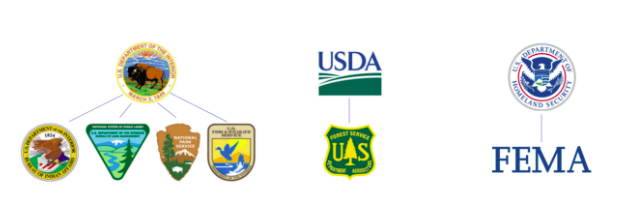
Funding the Fight Against Uncontrolled Megafires
Just as wildland fires in the U.S. are becoming larger, more frequent and more severe, the landscape of agencies and funding mechanisms aimed at combating the problem are growing, becoming ever more complex and intertwined.
Demystifying funding for wildland fire management will be key to forging better collaboration and more effective spending in this field. The Federation of American Scientists, along with our partners at Resources for the Future (RFF), unveiled the Federal Wildfire Funding Wheel at the end of last year as part of this effort. This post builds on that visualization of recent investments in wildfire funding, adding important context and detail on the annual budget process – with the caveat that policies and practices in this space are changing rapidly.
For decades, the main implementers of federal wildfire management were the U.S. Department of Agriculture’s Forest Service and the Department of the Interior. In FY 1994, the Forest Service (FS) and the Department of Interior (DOI) received less than $2 billion combined in annual appropriations for wildfire management. In FY 2022, that number nearly quadrupled to $7.5 billion.
Federal wildland fire appropriations from Congress provide agencies with funding for programs and can generally be categorized into four categories: preparedness, suppression, fuels management, and other activities.
- Preparedness activities fund firefighting resources and fire management assets to ensure readiness for wildfire response.
- Suppression activities focus on extinguishing or containing wildland fire and funds are most used for wildfire response.
- Fuels management refers to activities that remove potential fuels for wildland fire (e.g., vegetation or biomass) to reduce the severity and risk of future wildfires.
- Other activities include forest health management, burned area rehabilitation and restoration, post fire assistance programs, wildfire science and research, wildfire mitigation programs, community planning programs, and state or local fire assistance programs.
While a suite of activities are necessary to holistically manage wildland fire, in the last decade, nearly half of annual appropriations for wildfire distributed to the FS and DOI went toward funding suppression activities. There has been concern that rapidly growing suppression costs over the past decade reduces the availability of funding for other wildland fire programs and other DOI and FS programs more generally. The historic investments from the Infrastructure Investment and Jobs Act (IIJA) and the Inflation Reduction Act (IRA) should alleviate some of those concerns, as the funds will ultimately provide significant new resources for hazardous fuels mitigation, landscape restoration, and other programs such as improving community resilience, mitigation measures, science and research, and grants. Looking toward the future, public spending on wildland fire management will continue to increase. In this changing landscape, understanding where the federal government is investing in wildland fire management activities is crucial to ensuring that federal funds effectively tackle the growing challenges in this space.

While the Department of Interior and the Department of Agriculture may be the starting points for federal wildland fire management, a more granular breakdown is helpful for understanding how responsibilities flow:

Federal wildland fire management efforts have historically been concentrated in the two Cabinet-level departments: the U.S. Department of Agriculture (USDA) and the U.S. Department of the Interior (DOI). The USDA’s fire-related activities sit in a single agency – the U.S. Forest Service. The Department of the Interior’s Wildland Fire Management Program is more complex – the Office of Wildland Fire (OWF) coordinates wildland fire activities across DOI’s four land management bureaus with significant wildland fire budgets: the Bureau of Indian Affairs (BIA), the Bureau of Land Management (BLM), the National Park Service (NPS), and the U.S. Fish and Wildlife Service (FWS).
Given the increasing severity and intensity of catastrophic wildland fire events, The Department of Health and Human Services (HHS), through the Federal Emergency Management Agency (FEMA), is now playing a larger role in wildland fire activities, especially on the mitigation side. FEMA helps to distribute critical aid in response to wildland fire disasters and funds important cost-saving mitigation and resilience measures in communities.
How do wildfire funding decisions happen?
Every year, agencies work with the White House Office of Management and Budget (OMB) to prepare a budget that consists of detailed descriptions of accounts, programs, activities, their purposes, and requested discretionary appropriations for the fiscal year. Discretionary appropriations are funds allocated to agencies by Congress through the annual budget process.
These budget requests (or justifications) are submitted to Congress by the President and through the Congressional budget process, Congress ultimately grants funding (also called appropriating funds), for department and agency discretionary spending. Again, the majority of funding appropriated for wildland fire related activities currently goes to the Department of Interior’s Wildland Fire Management Program, the Forest Service, and FEMA.
Federal Budgeting and Wildland Fire Management
The core agencies responsible for wildland fire management each have different budget structures, but in general have accounts, programs nested within accounts, and activities carried out within programs (Accounts → Programs → Program Specific Activities). Accounts and Programs are generally represented as budget line items stating the level of funding received or requested.
U.S. Department of the Interior
All appropriated funds for wildland fire-related activities administered on DOI land are managed by the departmental-level Office of Wildland Fire. The Office of Wildland Fire works with the NPS, BLM, BIA, and FWS to prepare a department-wide wildland fire management budget called Interior’s Wildland Fire Management Program (WFM). DOI’s WFM is organized into the following accounts: Preparedness, Suppression, Fuels Management (Hazardous Fuels), Facilities, and Other Operations (Burned Area Rehabilitation, Facilities, Construction, and Maintenance, and the Joint Fire Science Program). DOI also receives emergency funding for suppression through the Wildlife Suppression and Operations Reserve Fund.
Forest Service
The Forest Service, like DOI, has a Wildland Fire Management Account that funds Preparedness, Suppression, and as of 2023, Hazardous Fuels. The Forest Service’s WFM Account is included in the agency’s annual budget justification document as its own line item. Unlike DOI, however, the Forest Service’s WFM account does not include funding for “Facilities” or “Other Operations.” Equivalent activities, and more, in the Forest Service’s budget are spread out across the rest of the agency’s accounts and programs. They are also often bundled with program activities not related to wildland fire management. For example, a program focused on forest health might include wildland fire risk reduction activities and invasive species management activities. Consequently, it becomes difficult to discern from budget line items exactly what percentage of Forest Service funds are allocated to these “other” wildland fire management activities.
Wildfire Suppression Operations Reserve Fund
The rising costs of suppression are the main reason baseline wildfire-related appropriations to FS and DOI have been trending upward. Since 2001, the Forest Service and DOI have regularly needed more funds for suppression than appropriated in the annual budget process. And the trend has only become more pronounced in recent years; Congress has had to provide FS and DOI with additional suppression funds 7 of the 10 years between FY 2011 and FY 2020 to replenish suppression funds or to repay funds transferred from other accounts to cover emergency suppression costs. In 2018, lawmakers created the Wildland Fire Suppression Operations Reserve Fund, or the “fire fix.” The fire fix is essentially an emergency fund for FS and DOI to tap into when baseline suppression funds become depleted. Instead of having to transfer funds from other internal programs or accounts for suppression efforts, the fire fix allows the Forest Service and DOI to budget for wildfire emergencies similar to other natural disasters.
FEMA Wildfire Funding
As mentioned above, as fires have become more catastrophic and destructive to communities, FEMA’s role in the wildland fire space has increased. But the disaster response agency structures its budget very differently than the Forest Service or DOI.
Funding for programs with wildland fire related activities are not as easily discernible when looking at budget line items in FEMA’s budget structure, but in general, they include activities related to firefighter personnel support (e.g., Fire Management Assistance Grants and Staffing for Adequate Fire and Emergency Response Grants), assets (e.g., Assistance to Firefighter Grants), technical assistance (U.S. Fire Administration), and grants to help communities mitigate and respond to fires (e.g., Hazard Mitigation Grants, Post Fire Hazard Mitigation Grants, and the Building Resilient Infrastructure and Communities Program).
Looking toward the future
It’s safe to assume that public spending on wildland fire issues will continue to increase for the foreseeable future– out of necessity and as agencies spend allocated funding from the IIJA and IRA. As wildfires grow and their effects feel more prominent, more and more federal entities are becoming involved in the space. Furthermore, there is uncertainty around exactly how funds are (and will be) allocated and how federal spending on wildland fire specific activities can be tracked in a consistent manner. Finding the correct balance of funding for prevention and prescribed burning, suppression and landscape and community rehabilitation – among other areas – will necessitate more data about and monitoring of federal spending. Increased transparency can help stakeholders make better-informed decisions as to what interventions are achieving intended results, and a necessary step for any individual or organization hoping to meaningfully impact the way the government addresses the changing ways wildland fires interact with our climate and our communities.
Impact Fellow Sonia Wang contributed to this report prior to beginning her assignment at the Office of Management and Budget.
FAS is also in the midst of conducting the Wildland Fire Policy Accelerator, with the goal of surfacing new voices and innovative practices in wildfire management. The recommendations emerging from the accelerator will involve the wider sphere of agencies and actors in the wildfire policy space, including the Environmental Protection Agency, the Centers for Disease Control and Prevention, as well as many state governments with important roles to play. The full list of policy recommendations will be submitted to the Wildland Fire Mitigation and Management Commission and will be released publicly soon.
This year’s Red Sky Summit was an opportunity to further consider what the role of fire tech can and should be – and how public policy can support its development, scaling, and application.
Promising examples of progress are emerging from the Boston metropolitan area that show the power of partnership between researchers, government officials, practitioners, and community-based organizations.
FAS supports the bipartisan Regional Leadership in Wildland Fire Research Act under review in the House, just as we supported the earlier Senate version. Rep. David Min (D-CA) and Rep. Gabe Evans (R-CO) are leading the bill.
The current wildfire management system is inadequate in the face of increasingly severe and damaging wildfires. Change is urgently needed